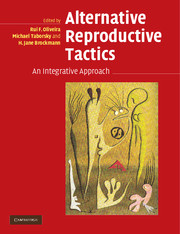Book contents
- Frontmatter
- Contents
- List of contributors
- Preface
- 1 The evolution of alternative reproductive tactics: concepts and questions
- PART I ULTIMATE CAUSES AND ORIGINS OF ALTERNATIVE REPRODUCTIVE TACTICS
- PART II PROXIMATE MECHANISMS OF ALTERNATIVE REPRODUCTIVE TACTICS
- PART III TAXONOMIC REVIEWS OF ALTERNATIVE REPRODUCTIVE TACTICS
- 8 Alternative reproductive tactics in insects
- 9 The expression of crustacean mating strategies
- 10 Alternative reproductive tactics in fish
- 11 Alternative reproductive tactics in amphibians
- 12 Alternative reproductive tactics in reptiles
- 13 Alternative reproductive tactics in birds
- 14 Alternative reproductive tactics in nonprimate male mammals
- 15 Alternative reproductive tactics in primates
- PART IV EMERGING PERSPECTIVES ON ALTERNATIVE REPRODUCTIVE TACTICS
- Index of species
- Subject index
- References
14 - Alternative reproductive tactics in nonprimate male mammals
Published online by Cambridge University Press: 10 August 2009
- Frontmatter
- Contents
- List of contributors
- Preface
- 1 The evolution of alternative reproductive tactics: concepts and questions
- PART I ULTIMATE CAUSES AND ORIGINS OF ALTERNATIVE REPRODUCTIVE TACTICS
- PART II PROXIMATE MECHANISMS OF ALTERNATIVE REPRODUCTIVE TACTICS
- PART III TAXONOMIC REVIEWS OF ALTERNATIVE REPRODUCTIVE TACTICS
- 8 Alternative reproductive tactics in insects
- 9 The expression of crustacean mating strategies
- 10 Alternative reproductive tactics in fish
- 11 Alternative reproductive tactics in amphibians
- 12 Alternative reproductive tactics in reptiles
- 13 Alternative reproductive tactics in birds
- 14 Alternative reproductive tactics in nonprimate male mammals
- 15 Alternative reproductive tactics in primates
- PART IV EMERGING PERSPECTIVES ON ALTERNATIVE REPRODUCTIVE TACTICS
- Index of species
- Subject index
- References
Summary
CHAPTER SUMMARY
Alternative reproductive tactics in male mammals fall into two categories: unequal pay-offs, in which a younger or subordinate individual assumes a lower fitness tactic in response to the frequency and competitive ability of other males in the population, and equal pay-offs, in which ecological or environmental factors dictate alternative tactics based on distribution of resources, population density, and demographic conditions. The tactic(s) used in both situations are conditional and are based on social and ecological environments, respectively, and on the relative social status of competitors. The decision-making rules for adopting a particular tactic for any individual at any one time in its life are based on its age, status, competitive ability, or current environmental conditions; these rules will ultimately maximize the individual's lifetime reproductive success. The reproductive tactic used by an individual may vary throughout its lifetime or seasonally. Herein I provide examples of selective forces and relative fitness pay-offs for alternative reproductive tactics used by a variety of male mammals under different social and ecological conditions.
INTRODUCTION
Mating systems are viewed as an outcome of individual, reproductive strategies that have been subjected to natural selection and have become characteristics of given species (Gross 1996). A reproductive strategy may have one or more alternative tactics, each conditionally dependent on factors such as social status, frequency of alternatives, population density, and environmental factors (Dominey 1984, Taborsky 1994, Gross 1996, Brockmann 2001). Following the logic of Gross (1996), I view alternative reproductive tactics (actually phenotypes) from two perspectives.
- Type
- Chapter
- Information
- Alternative Reproductive TacticsAn Integrative Approach, pp. 356 - 372Publisher: Cambridge University PressPrint publication year: 2008
References
- 20
- Cited by



